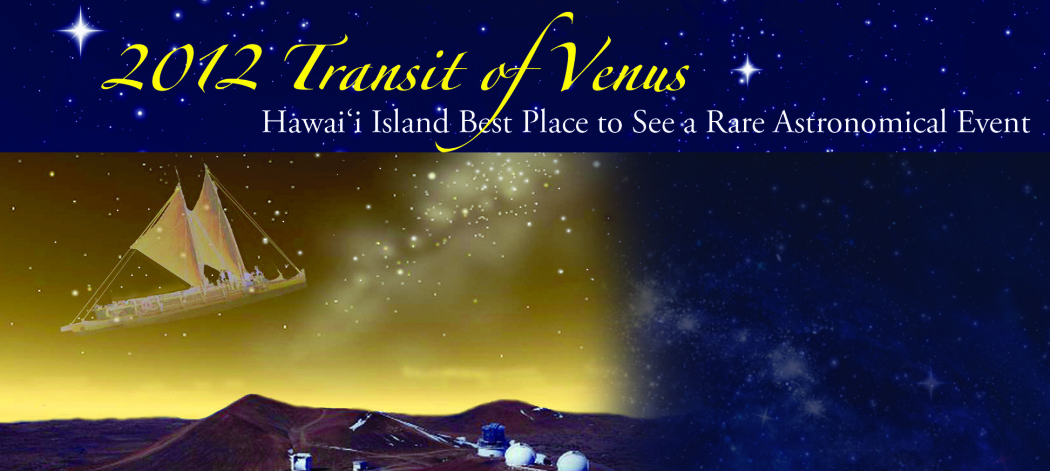
2012 Transit of Venus: Hawai‘i Island Best Place to See a Rare Astronomical Event
 By Jon Lomberg
By Jon Lomberg
June 5, 2012
On June 5, 2012, the Earth, Sun, and the planet Venus will briefly line up, and Venus will slowly move across the Sun’s face, like a tiny eclipse. This is in fact the rarest eclipse visible from Earth, called a transit of Venus. There have been only 53 of them since 2000 B.C. There was not a single transit in the entire 20th century. When they happen, they happen in pairs, eight years apart. The last one was in 2004, and its eight-year twin will be on June 5, 2012.
Since each transit is completed in a few hours—six hours in 2004—it is visible only to the hemisphere facing the Sun during that time. West Coasters will see it begin before the Sun sets for them. To see the entire transit, American astronomers are flocking to Hawai‘i’s observatories, from which the entire transit can be observed. (It’s visible in Alaska, too.) They will be joined by thousands of astro-tourists toting cameras and telescopes. This event will join a long tradition in which the islands of Polynesia are linked to astronomy.
In fact, this is really a feast for the mind, not for the eyes. Unlike the better-known solar and lunar eclipses, the transit of Venus is a visually unspectacular event, just a small black dot taking all afternoon to move across the face of the Sun. Even with sun filters for safety, you’ll need sharp eyes to spot that tiny dot. But what an important dot it is! So important that it got astronomers tangled up in the rocky history of Western contact with Pacific culture. Their quest to observe this seldom-seen event brought scientists to Tahiti in 1769 and to Hawai‘i in 1874; both times the impact on the islanders was profound.
1769
It was a transit of Venus that prompted Captain Cook’s first voyage into the Pacific in 1769, specifically to observe the phenomenon. Earlier that century, Edmund Halley, namesake of the famous comet, published a mathematical method by which the transit could be used to measure the distance from the Earth to the Sun. The trick to Halley’s method was making accurately timed observations from different parts of the world and comparing when widely separated observers saw the event. Astronomers could then apply Halley’s method, using geometry to calculate the distance to the Sun with unprecedented accuracy.
Who cared? And why send a ship all the way to Tahiti to find out? The interest was not purely scientific. Knowing the distance to the Sun would improve the accuracy of navigation and reduce the enormous losses of men and ships due to the poor navigation of that period. In those pre-GPS days, all navigation was done by observing changing positions of the Sun, Moon and stars during a voyage.
Their positions could be predicted by the science of celestial mechanics.
Celestial mechanics is the study of how objects move in space. The orbital motions of the Sun, Earth and Moon can be understood and predicted using the laws of motion formulated by Sir Isaac Newton in the mid-1600s. This science has been among the most generous to society, explaining as it does the timing of sunsets, tides, eclipses, and transits. By the 1700s, Western navigators realized that improvements in celestial mechanics would allow improvements in navigation. Astronomical charts and tables could tell a ship captain where the Sun, Moon and planets would be seen at any location and at any time.
But to work the equations in their celestial mechanics, astronomers needed to know the distance to the Sun.
Halley didn’t live long enough to see the next transit in 1761. But he didn’t miss much. Bad weather in Europe and Africa frustrated most observers trying to see that transit from Europe and Africa. Among those disappointed in South Africa were the astronomer/surveyors Charles Mason and Jeremiah Dixon, who later established their eponymic line dividing Pennsylvania, Maryland, Delaware, and Virginia (and, in the Civil War, North from South).
Astronomers had eight years to prepare for the next transit in the pair and that one would not be visible from Europe.
So Britain decided to send its most able sea captain, James Cook, to an ideal observing site halfway around the world to make the observations sought by the British admiralty. In 1769 Cook sailed the bark Endeavor to the Pacific island of Tahiti, which had been reached by the first Europeans only two years earlier. It was perfectly situated for observing. Cook and astronomer Charles Green came well prepared with a portable observatory.
Cook successfully arrived in Tahiti in time to establish his observatory at what is still called Point Venus, on the northernmost tip of the island. He and Green made their observations and sailed home, their epic voyage taking them through storm and shipwreck, discovering Australia along the way. Cook’s navigation was perfect, but 40 percent of the crew, including astronomer Green, perished from tropical disease on the final leg of the trip home. Such losses were considered normal in those days.
Captain Cook’s voyage thrilled all of Europe and sparked a new wave of exploration by Western navies. Unfortunately, Cook and Green’s transit observations were not accurate enough to fix the Sun’s distance—their optical and timekeeping instruments were just not good enough for the task.
Cook was to make two more epic Pacific voyages and his name is honored all over the hemisphere, from Vancouver Island to Sydney Harbour. His final voyage was the first European contact with Hawai‘i, the most remote chain of islands in the world.
In 1779 Cook landed at Kealakekua Bay and ultimately suffered a tragic fate arising from the profound misunderstanding between the Hawaiians and the English. That tale has been told often and well. Less well known is the fact that, before his death, Cook used his portable observatory to fix Hawai‘i’s latitude and longitude. Maps would finally show Western navigators how to find Hawai‘i.
Of course the Polynesians had mastered this feat centuries earlier, canoeing thousands of miles across the ocean with nothing but a song and the stars to guide them. One of the ironies of history is that Cook, the greatest navigator of his age, remained ignorant of the depth of navigational wisdom possessed by the Pacific peoples that he met.
Cook’s measurements were precise and skillful, and his charting of Hawai‘i’s location was accurate enough to remain in use until the next transit of Venus expedition made even more precise measurements.
1874
The next transit occurred on December 9, 1874, and the full story is in the new book Hokulua by astronomer Michael Chauvin (Bishop Museum Press) in which these 1874 photographs appear. Again it was not visible from Europe, and again the British sent an expedition to the Pacific to observe it, this time in Hawai‘i. In fact, observations were done from several places in the Hawaiian Islands, including Kailua-Kona on Hawai‘i Island. This time relations between the Hawaiians and the British were much smoother. Hawai‘i’s new king, David Kalākaua, was an educated man who loved the arts and sciences and gave the British every possible help in making their observations. He offered them suitable land in ‘Āpua, not far from the Honolulu waterfront, which the astronomers fenced in and filled with a small but well-equipped observatory. He also allowed the preparation of another observing site in Kailua-Kona, which would lessen the chance of being completely clouded out by bad weather over one island.
The big day came with clear weather in the sky, but trouble on the ground. (See sidebar)
Even with their expertise, the British failed to improve the estimate of the Sun’s distance. By 1874 navigators relied on marine chronometers to fix the location of a ship relative to Greenwich, England, so the Sun’s distance was far less important to navigation. Still, Tupman was disappointed that it was not until the 1882 transit of Venus (second in that pair) that the commonly accepted value of about 93 million miles was determined by the American astronomer Simon Newcomb.
The 1874 expedition was also interested in studying the slight halo that appeared around Venus at the moment the planet appeared to touch the Sun, visible in Charles Green’s drawing. This was caused by the Sun’s light passing through the planet’s atmosphere, and was the first proof that Venus had an atmosphere at all. It’s a wonderful example of how scientists use such small details to reveal enormous secrets.
Before they left Hawai‘i, the British had one final act of homage to perform. They erected a monument at the site of Captain James Cook’s death at Kealakekua Bay, now a well-visited attraction for travelers.
I am among the dedicated stargazers attracted to Hawai‘i by its peerless skies and by discoveries by observatories from all over the world, sharing the summit of lofty Mauna Kea. This continuing association of Pacific islands with astronomy could not be more appropriate. Without astronomy, none of the islands of the Pacific would have human populations. From the very beginning of human settlement in Hawai‘i until the present day, Hawai‘i is where the Universe comes down to Earth, and where human curiosity reaches out to the stars. ❖
ABOUT THE AUTHOR: Hawai‘i Island resident and Emmy Award-winning artist Jon Lomberg was Carl Sagan’s colleague on the TV series Cosmos and the film Contact. Asteroid Lomberg was officially named in his honor in 1998. He was design director for NASA’s legendary Voyager Golden Record, and has sent artwork to Mars aboard NASA’s Phoenix, Spirit, Opportunity and Curiosity spacecraft. A Big Island resident since 1987, Mr. Lomberg works with the Mauna Kea Observatories in astronomy outreach, including tours of the Galaxy Garden he designed at Paleaku Peace Gardens in Hōnaunau. See: galaxygarden.net and jonlomberg.com He blogs at citizenofthegalaxy.com
For more information: transitofvenus.org
NASA eclipse information: http://eclipse.gsfc.nasa.gov/transit/venus0412.html
WARNING! Looking directly at the sun without proper sun filters can cause permanent blindness in seconds. Photo film and colored glass will NOT block the harmful radiation. Some recommended methods are via rear projection screen, solar filtered telescope, #14 or greater welding glass, disposable “eclipse shades” and live webcast. There are even apps for cell phones. Find more information about how to view the sun safely at: transitofvenus.org
Astronomers vs. Hawaiians: A Viewpoint
By Jon Lomberg
In the story of Western contact with Hawai‘i, the tradition of scientific observation has played a noble part. But sadly, another tradition also exists, and that is the lack of trust between astronomers and people from the communities in which they observe. This animosity has been present since the 1874 British expedition brought in the first wave of astronomers eager to observe. Just look at what happened then.
About three weeks after King David Kalākaua warmly welcomed the astronomers, he paid them an unannounced visit and proposed the astronomers celebrate a week of festivities with his people, who could be shown the observatory and look through the telescopes. There would be music by the King’s own orchestra, hula, feasts… the king would lay it on royally.
What a generous impulse on the part of the young ruler!
He knew exactly what the astronomers were doing and why, and he wanted to share that with his people, themselves heirs to a long tradition of astronomy.
The astronomers listened and subsequently ignored King Kalākaua’s proposal. Expedition leader Dr. George Tupman even recorded his irritation with being interrupted at his work. Clearly he felt the idea of a star party was impertinent. There was no way they were letting Hawaiians get anywhere near the telescopes. Tupman, of course, neither knew nor cared about Hawaiian astronomy. The voyages of the canoe Hokule’a were a hundred years in the future. Until then, Hawai‘i’s indigenous astronomical tradition was ignored by almost everyone.
Tupman’s arrogant attitude is characteristic of his era. These were men of their time, colonialists who had brought tinned fruit with them to eat in Hawai‘i. And they were the first to commit a civic error fatal to community support: lack of sincere interest in education and outreach. Would they have been so dismissive of the king’s idea had it come from a white European monarch?
On Dec.9, 1874, the day of the transit, Kalākaua was in Washington D.C., hammering out the historic Reciprocity Treaty with Congress and meeting President Ulysses. S. Grant. Meanwhile, back in Honolulu, crowds of citizens in their party clothes started gathering to share the big event with their astronomer guests. But the astronomers had no intention of sharing it with anyone. A standoff followed and grew heated, and the atmosphere had changed from one of a party to a hostile confrontation. This so alarmed Queen Kapi‘olani that she and the Dowager Queen Emma had to appeal to the crowd for calm.
So what did the British do? Set up a telescope or two and teach some astronomy? Show the kids the craters of the Moon and the rings of Saturn? No, instead the British Commissioner promptly landed marines from HMS Scout to maintain order, Empire-fashion, with armed troops. The first observatory in Hawai‘i came within a whisker of being sacked by an angry mob, thus recapitulating Cook’s own fate when he underestimated the dignity and resolve of Hawaiian people.
To me this history is a parable. In recent years our Hawai‘i Island observatories have made some efforts at outreach through lecture series, exhibits, etc., but the central problem remains disturbingly similar to the way it was back in 1874. Despite some admirable individual efforts, outreach programs of the Mauna Kea observatories are still understaffed, underfunded, and the first thing to be cut when budgets are trimmed. The attitude persists among astronomers that public education is not their job. It is a marginalized afterthought at best.
Residents and visitors can enjoy the excellent programs at the ‘Imiloa Astronomy Center, which is not affiliated with any observatory. The Big Island should be the voice of astronomy to the world—starting with all island residents. Astronomers have to accept the responsibility of sharing their knowledge of the Cosmos. Everybody is interested. And for Hawaiians, it’s in their blood.


